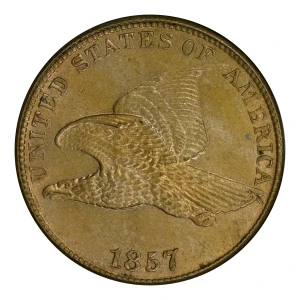In the first half of the 18th century, one cent coins were large, clunky copper pieces nearly the size of a modern half dollar. By 1856, the cost of producing these copper coins rose so high that the U.S. mint was forced to significantly reduce their size. In 1857, the mint debuted a new small diameter cent, the Flying Eagle cent, which was the same size as our modern-day cent. The obverse of an eagle in flight is believed to have been modeled after “Peter the Eagle,” a tame Bald Eagle kept by Philadelphia Mint workers from 1830-1836. Peter stayed in the mint during the day and was let out to fly at night. His wing was eventually caught in machinery, and he was accidentally killed. The revered bird was stuffed and is still displayed at the mint today. The reverse of the coin features a wreath of corn, cotton, wheat, and tobacco—agricultural products of both the North and South. Unfortunately, due to difficulties in production and issues with strike quality, this new cent was quickly abandoned and replaced by the Indian Head cent, which was minted through 1909. Longacre’s famous eagle design has been long admired by collectors who seek to complete this short but difficult 3-year series.





